-
Content Count
343 -
Joined
-
Last visited
-
Days Won
4
Posts posted by shineworld
-
-
I use practically 90% of TFrame and 10% of TForm.
IDE sometimes is wrong to place or list the available TFrame so I add them programmatically.
No issue in this way. -
10 hours ago, Adam said:Grazie Shineworld,
Un modo ingegnoso per farlo. Al momento ho il sospetto che parte del mio problema sia che il mio ramo non è stato ancora aggiornato per funzionare con Delphi 12. Potrei sbagliarmi, aspetto solo prima la conferma.
I'm some commits far from latest in Indy10 git repository but to work I've:
1] moved all files in folder from git project to be close on what I've found on Delphi
2] changed the .inc to be close to Delphi originals
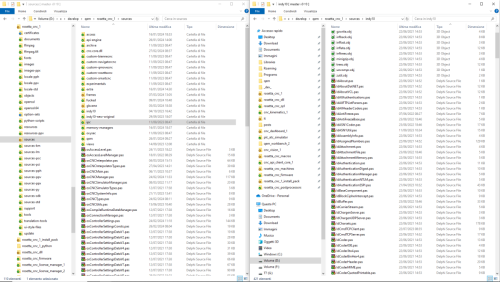
all work fine and I'm free to modify Indy to meet my "odd and old" protocols...-
 1
1
-
-
-
I'm used to using a different Indy version in some programs.
I've left the official Indy of Delphi installation and I don't touch it.
In a project I add a sources\Indyxx path with the desired Indy version source code.
Usually this is a modified version of the current GitHub because I need to manage some base mechanism to adapt it to my embedded devices.
In the program options I added this path to Search Path:

Obviously I don't use IDE to place Indy components onto form but I've to create them programmatically.
At now building exe Delphi uses .\sources\Indy10 version file instead of Delphi native Indy.-
 2
2
-
 1
1
-
-
Perhaps the solution is to watch what VTK do with tkinter to implement the vtkTkRenderWindowInteractor.
I will study and try to do a close thing with a compatible DelphiVCL Windows based component.
https://github.com/Kitware/VTK/blob/master/Wrapping/Python/vtkmodules/tk/vtkTkRenderWindowInteractor.py -
Yes, maybe I explained myself wrongly.
I am using Python + VTK + QT.
VTK is a very good Python library for working with 3D scenes.
QT is terrible for me and I love DelphiVCL e DelphiFMX UI for Python.
Unfortunately, to do the rest of the interface, I had to switch from Python4Delphi (DelphiVCL or DelphiFMX) to QT precisely becausethere is a lack of coverage to OpenGL in them, and however, found no way to integrate VTK to DelphiVCL/DelphiFM.
So I was asking if anyone had already done this or could point me to how to create a VTK component that would appear in an area
of a Python DelphiVCL TForm, as in the example in the picture below.
-
Hi all.
Recently I've been using VTK to manage 3D Views.
Unfortunately, I've found only info on how to use it with QT Pyside6 with QVTKRenderWindowInteractor.
I will hope to use DelphiVCL (my first choice) or DelphiFMX + VTK.
Do you have any idea on how to use VTK in a TForm or any other Windows-based window object? -
1. Sorry for mistakes in post, I never studied English.
2. I use GExpert, and I've to thank the project manager, but I would like to have a better grep in the native IDE.
3. Usually mine are very big project subdivided in many customized versions managed as project group with shared sources. To manage manually the versions info for single project is an hard work which requires jumps as like as a monkey in the three. DDExpert does something to simplify.
4. OpenGL and 2D mix is not so unusual in industry automation related projects, where Delphi, at least in Italy, is yet used also by big firms. I k know FMX, but it's not a level of VCL for many reasons, at least in my cases.
Some samples on how VCL + OpenGL can live and be happy:
https://youtu.be/3IC15XM_8ow?si=RLuDHZmpU9PgdFj7
And as VCL + OpenGL + Python are a good team:
-
For me:
- arm64 compiler for Linux
- a better refractory tool (often fails also with 100% compilable project) that can work also at a project group level.
- grep as like as available in GExperts
- sort lines as like as available in GExpers
- set version info (to fastly manage version info in a group of projects) as like as in DDevExtension
- an Embarcadero-managed OpenGL / Vulkan library, like GLScene, for VCL.
- a more simple way to create ActiveX (to migrate Delphi-made visual components to other platforms).
-
When you have collected all the ideas, it would be interesting to add a pool where everyone gives one or more preferences. Just to understand what is really needed.
-
Interesting solution.
-
I've used a TComboBox set as List because arguments start from None, 1, 2 .. 256 and use can fastly move to any using key:

However, I guess I to move them to the Edit field and check the entered data as suggested.
In the past I've used old SweedControls combobox made by zero with Delphi code but moving to 64bit the old and not supported library does not work fine. -
A native VCL, and not Windows-based, TComboBox cotrol.
In one application I have hundreds and hundreds of TComboBoxes with values None and then from 1 to 256.
I have used many strategies to enter values in these combos but the time required is enormous.
The fastest system was to leave them empty, at FormCreate create the fields by hand by searching
all TComboBox components ...... and on some PCs it takes almost 3 or more seconds....// creates components hash and binds component events to code and adds inputs/outputs items C := ComponentCount - 1; for I := 0 to C do begin Component := Components[I]; FComponentsHashManager.Add(Component); if Component is TComboBox then begin with TComboBox(Component) do begin if Pos('InputNum', Name) <> 0 then begin SendMessage(Handle, WM_SETREDRAW, Ord(False), 0); SendMessage(Handle, CB_INITSTORAGE, I_O.MAX_DIGITAL_INPUTS + 1, COMBOBOX_MAX_TEXT_LENGTH * (I_O.MAX_DIGITAL_INPUTS + 1)); for J := 0 to I_O.MAX_DIGITAL_INPUTS do Items.Insert(J, InputsList.Strings[J]); SendMessage(Handle, WM_SETREDRAW, Ord(True), 0); Continue; end; if Pos('OutNum', Name) <> 0 then begin SendMessage(Handle, WM_SETREDRAW, Ord(False), 0); SendMessage(Handle, CB_INITSTORAGE, I_O.MAX_DIGITAL_OUTPUTS + 1, COMBOBOX_MAX_TEXT_LENGTH * (I_O.MAX_DIGITAL_OUTPUTS + 1)); for J := 0 to I_O.MAX_DIGITAL_OUTPUTS do Items.Insert(J, OutputsList.Strings[J]); SendMessage(Handle, WM_SETREDRAW, Ord(True), 0); Continue; end; end; end; ...
-
Me to. Updated to 1st of most (I hope) patches 🙂
-
For the Remote Support, you can choose a lot of tools (AnyDesk, Teamviewer, Supremo, etc.).
In recent times a new actor has entered the scene: RustDesk.
RustDesk is an open-source project made with Rust.
RustDesk covers either client or server.
So you can use default open servers or if you have an external server you can place your RusDesk server in your net service.
https://github.com/rustdesk/rustdesk
I'm used to placing some of them in my software (some customized with annual payment, and rust desk as an open system):
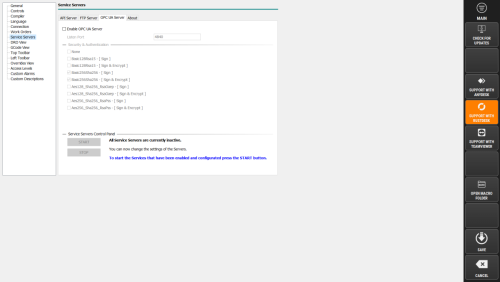
End-users can so choose what remote support service prefer to use (and what does not have connection issues at that time).
-
Hi all.
I'm trying to use Skia TSkPaintBox on Athens VCL application.
I've enabled Skia in the project.
I can use TSkLabel.
I can place a TSkPaintBox.
And run...
But if I try to create the TSkPaintBox Draw event I get this error:
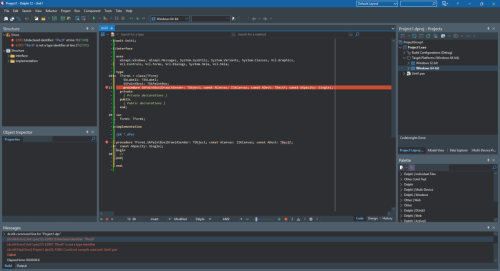
[dcc64 Error] Unit1.pas(13): E2003 Undeclared identifier: 'TRectF'
[dcc64 Error] Unit1.pas(27): E2005 'TRectF' is not a type identifier
[dcc64 Fatal Error] Project1.dpr(5): F2063 Could not compile used unit 'Unit1.pas'
Thank you in advance for your answers.
Best regards
Silverio -
I don't know if support Unicode (I guess) but I've used it in past years and was very simple to use:
https://www.remobjects.com/ps.aspx -
Appreciated exemplify.
I need to start using Gist too. -
5 minutes ago, Lars Fosdal said:Things like GitHub gists or PasteBin entries, are great ways of sharing walls of code.
OK!
Some forums do not permit, by forum rules, to attach external code links.
Next will use Pastebin.
-
I've missed to set PassTrough 🙂
error = 1 stay for OK, another my misunderstanding.
-
After finishing and testing the configuration to have TLS 1.2 on TIdFTPServer I was asked to add OpenSSL and TLS 1.2 also on the API server (based on TIdTCPServer TCP/IP communication).
Unfortunately when I set Active to True, and IdSSLOpenSSL.InitContext is called, in the CiperList settings step it always returns error = 1 and I don't understand what I am doing wrong:
if StatusInfoOn then begin SSL_CTX_set_info_callback(fContext, InfoCallback); end; //if_SSL_CTX_set_tmp_rsa_callback(hSSLContext, @RSACallback); if fCipherList <> '' then begin {Do not Localize} error := SSL_CTX_set_cipher_list(fContext, {$IFDEF USE_MARSHALLED_PTRS} M.AsAnsi(fCipherList).ToPointer {$ELSE} PAnsiChar( {$IFDEF STRING_IS_ANSI} fCipherList {$ELSE} AnsiString(fCipherList) // explicit cast to Ansi {$ENDIF} ) {$ENDIF} ); end else begin // RLebeau: don't override OpenSSL's default. As OpenSSL evolves, the // SSL_DEFAULT_CIPHER_LIST constant defined in the C/C++ SDK may change, // while Indy's define of it might take some time to catch up. We don't // want users using an older default with newer DLLs... (* error := SSL_CTX_set_cipher_list(fContext, {$IFDEF USE_MARSHALLED_PTRS} M.AsAnsi(SSL_DEFAULT_CIPHER_LIST).ToPointer {$ELSE} SSL_DEFAULT_CIPHER_LIST {$ENDIF} ); *) error := 1; end;
Server code:
https://pastebin.com/z82zhGyQ
I am using the latest Indy sources from the git repository.
I thank you in advance for any suggestions
Best Regards
Silverio -
On 12/28/2023 at 11:46 AM, DelphiUdIT said:And in the industrial sector this causes quite serious problems: every time something is changed the entire system must be validated again with considerable costs and resources.
Try to think if a system made a "braking control" pass off as good when in fact it isn't....In Industry is very hard to think to use C# or Java which are so simple to decompilate and back to source code.
-
Hi all.
For someone could be a silly question but important for me.
Today I've purchased Athens, and usually I work with Sydney.
I have a lot of very big projects made with Sydney and moving them to Athens will be a long path ( a lot of 3rd parties libraries to install).
Can I install Athens on the same PC where Sydney works ?
If YES, are there some types of attention to be kept?
At the moment I've also Code Gear RAD Studio 2007 for very old projects not ported to Sydney which live without problems with Sydney. -
My 2 cents.
I have been battling, or rather, living with the constant crashing of the Delphi Sydney 10.4.1 IDE for months and months.
All I had to do was open the IDE and close it to get the protected memory access error rtl270.bplI tried uninstalling all plugins (GExpert, Parnassus, etc).
No luck.Following your directions I removed the installed libraries one by one and, as Murphy teaches, when I removed the penultimate one the problem disappeared.
Basically I was using an old, but not much, library called Graphics32 which in the IDE shutdown phase was sending everything into a tailspin. Updated to the latest version now everything works perfectly.
![Delphi-PRAXiS [en]](https://en.delphipraxis.net/uploads/monthly_2018_12/logo.png.be76d93fcd709295cb24de51900e5888.png)


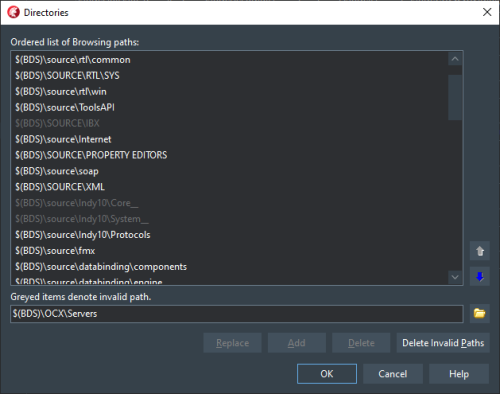
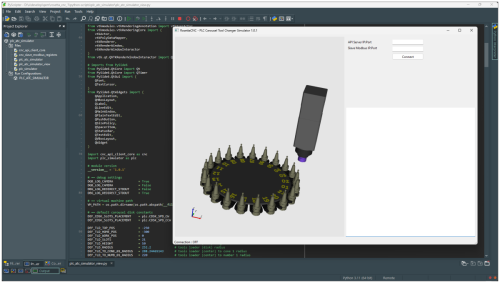
What new features would you like to see in Delphi 13?
in Delphi IDE and APIs
Posted
Delphi can use external DLL made with C.
I Delphi13 will be useful to import DLL made with C++ to open road to use directly tools like OpenCV, VTK, numpy, etc.
I don't know how complex it is but would be amazing...